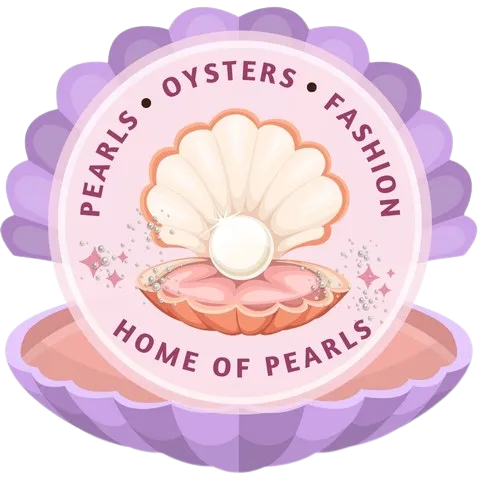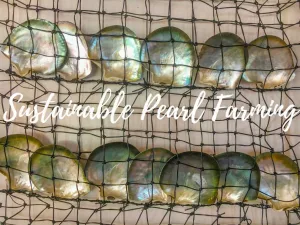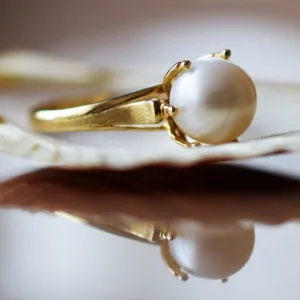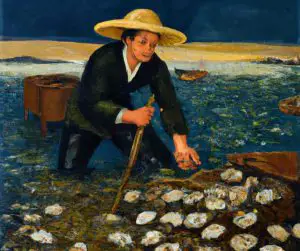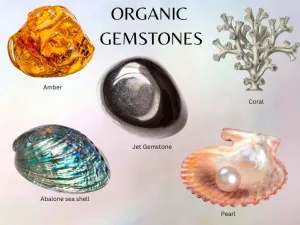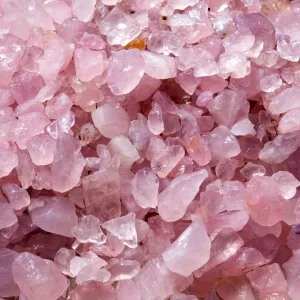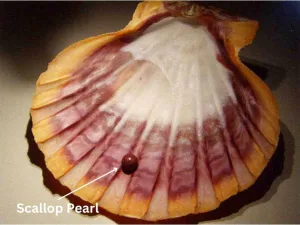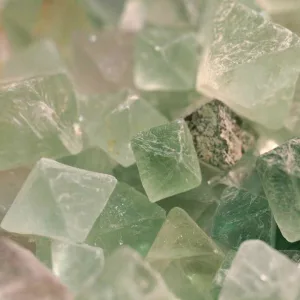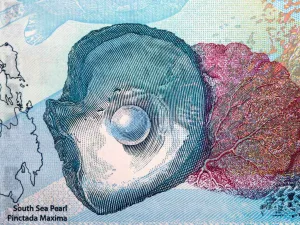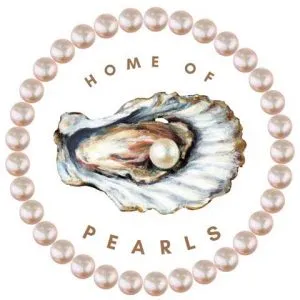Introduction
The classification of pearls can be quite a complicated subject. There are three large groups of pearls, these include natural pearls, cultured pearls, and simulated pearls.
Table of Contents
- Introduction
- Natural Pearls
- Cultured Pearls
- Akoya pearls
- Tahitian pearls
- Cultured south sea pearls
- Freshwater pearls
- Sea of Cortez Pearls
- Simulated pearls
- Pearl Like Concretions
- Takeaway
| Type of pearl | Location | Examples |
|---|---|---|
| Natural Pearls | ||
| Cultured Pearls | Japan and Australia | Akoya |
| Astralia, Indonesia and Tahiti | South Sea Saltwater | |
| China | Fresh Water | |
| Simulated Pearls | Man made (plastics, glass and resin) |
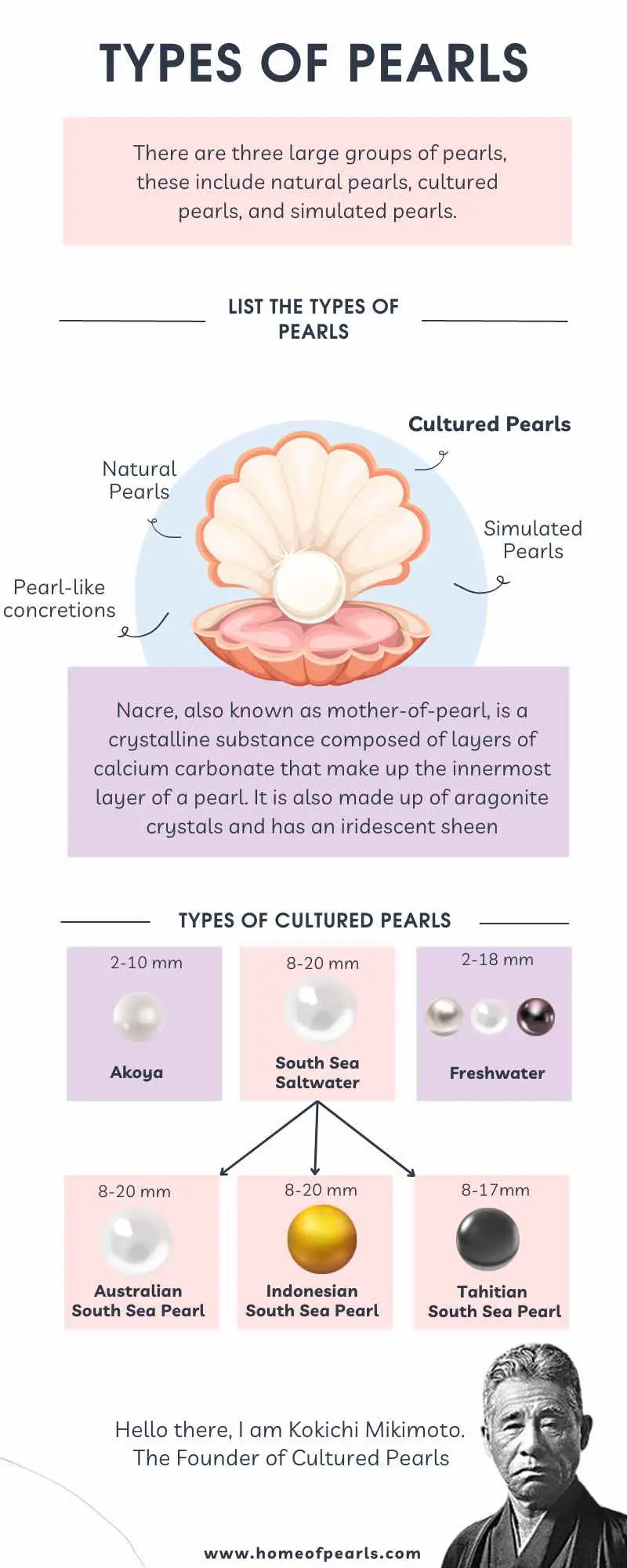
Natural Pearls
Natural pearls are ones that are found in the wild in an oyster that has been growing from an irritant such as a grain of sand. These are fairly rare and they were pearls that were available before cultured pearl and became the norm in 1902 to 1903 (invented by a Japanese known as Mikimoto). Natural pearls are fairly rare and highly valuable and normally something that you won’t find in a commercial store.
Cultured Pearls
A cultured pearl is a term referring to a pearl that is produced by living organisms i.e. an oyster or mussel. These pearls are produced through the intervention of man. It involves inserting a little piece of mantle tissue in the soft tissue of a freshwater mussel to instigate pearl growth.
Akoya pearls
Akoya pearls are the most popular and widely available type of cultured pearl. The classic pearl cultivated by Mikimoto utilized an Akoya oyster.
These saltwater gems are usually farmed in Japan, China, Vietnam, or Thailand and range from white to cream in color with rose (mixture of pink and cream) or silver overtones. Akoya pearls come in a variety of shapes including round, oval, drop and button—each of which has its own unique appeal.
The luster and quality of Akoya pearls is known to be exceptional due to the precise care taken during their culturing process. They range from 2 to 10mm in size.

Perfectly suited for both daytime and evening wear, these exquisite gems have become a staple among jewelry enthusiasts. With timeless elegance and sophisticated style, Akoya pearls are the perfect way to add a touch of luxury to any outfit. When properly cared for, these captivating gems will last for generations—making them outstanding heirloom pieces that can be treasured forever.
Tahitian pearls
Tahitian pearls (also a type of south sea saltwater pearl) are a type of black pearl produced by the black-lipped oyster found in the lagoons of French Polynesia.
These oysters are slightly smaller than other south sea oysters, such as the white-lipped and gold-lipped oysters of Australian and Indonesian waters, respectively.
These unique and exotic gems have varying color tones ranging from light silver to deep charcoal grey, some with hints of blue or green hues. They are produced by a black-lipped oyster.
The most priced color of the Tahitian pearl is described as “Peacock colored”.
Generally round in shape, Tahitian Pearls measure between 8mm – 17mm in size and demand the highest prices among saltwater cultured pearls. The most popular types of jewelry featuring Tahitian Pearls include earrings, necklaces, and bracelets.
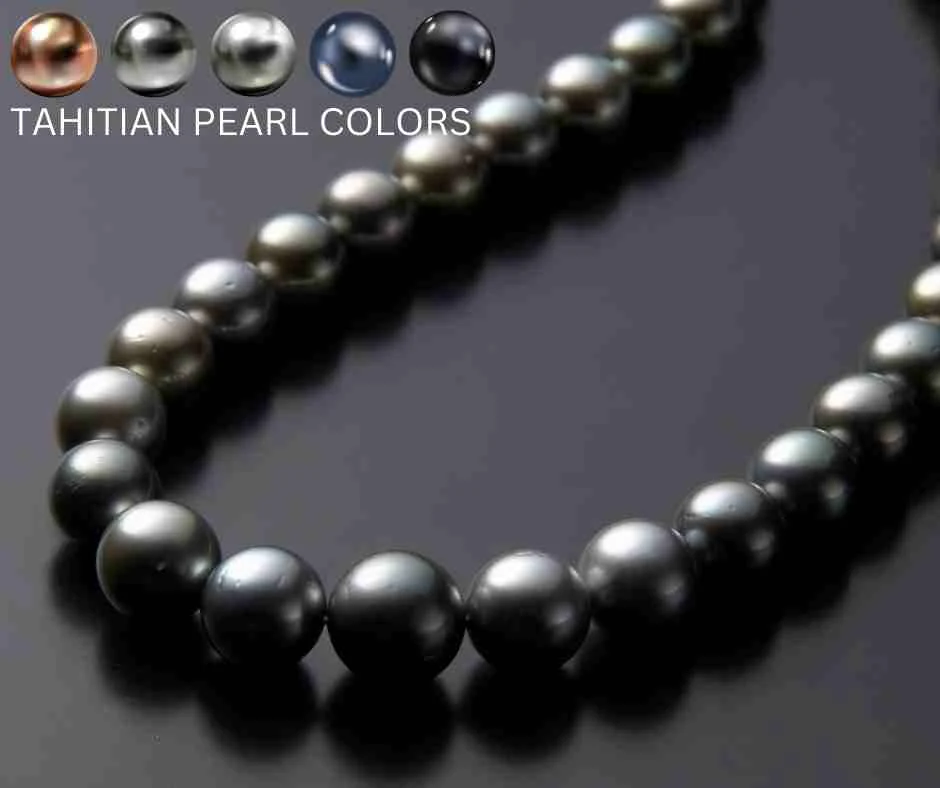
Tahitian Pearl farming is an intricate process requiring sustainable management practices that must be regulated by governments to protect these precious resources for future generations. With features such as a smooth surface and stunning colors, it’s no wonder why Tahitian Pearls are so highly sought after.
They provide that perfect finishing touch to any jewelry piece, making them the ideal choice for anyone looking for something truly unique and special. With beauty that cannot be duplicated, Tahitian Pearls remain one of the most treasured gems in existence today.
As an investment or simply as a fashion statement, these rare and beautiful pearls are sure to make an eye-catching addition to any collection. Because they are such high-quality gems with intricate features, Tahitian Pearls command some of the highest prices among pearl varieties available on the market today.
Whether you’re looking for something special for yourself or a loved one, Tahitian Pearls are sure to make a perfect choice.
For those looking for something truly unique, there’s no better option than the exquisite beauty of Tahitian Pearls. With their mesmerizing colors and smooth surfaces, these gems offer an elegant look that is sure to turn heads. Whether you’re searching for something special for yourself or a loved one, these stunning pearls are guaranteed to leave a lasting impression.
Cultured south sea pearls
South Sea Saltwater Pearls are some of the most sought after and valuable pearls in the world, prized for their stunning natural luster. These gems come from a variety of oysters found in the South Pacific Ocean near Australia, Indonesia, and the Philippines.
They are known for having large sizes and soft hues ranging from creamy white to golden yellow, often with hints of pink or green. Their incredible beauty earned them the name “Queen of Gems” among connoisseurs and gem collectors alike.
The silver-lipped oyster produces the Australian pearl, while the gold-lipped oyster produces the indonesian pearl.
South sea pearls are cultured from relatively larger oysters than the Akoya pearls, thus they tend be larger. The average size of south sea pearls, be they Australian, Indonesian or Tahitian is anywhere from 8-20mm.
Australian south sea pearls tend to be white with an occasional blue to grey overtone to them. Also, they may sometimes have a pink tone. They can also be creamish in color.
Indonesian south sea pearls are typically golden yellow or light creamish yellow in color.
South Sea Pearls can be found in various shapes including round, oval, drop-shape, semi-baroque, baroque, button-shape and many more unique variations. As these pearls are generally quite rare, they tend to be more expensive than other types of pearls.
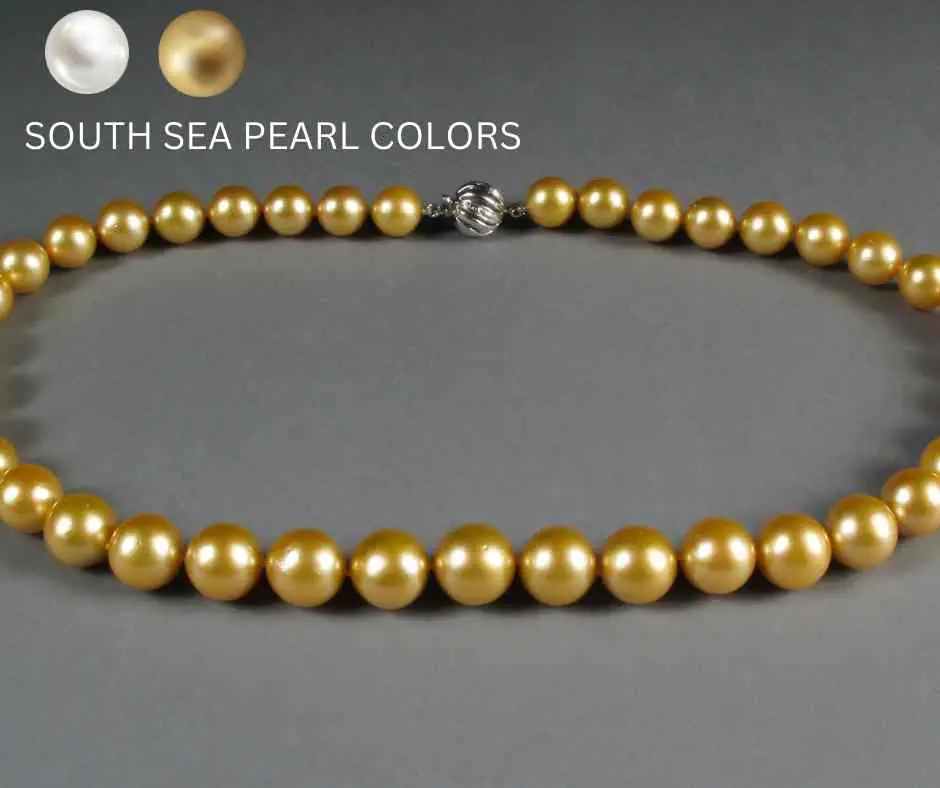
They often symbolize wealth, luxury and opulence, making them perfect for special occasions like anniversaries, engagements or weddings. South Sea Pearls are truly a treasure that can last through generations with the proper care and attention. With their exquisite beauty and rarity, these gems will always remain a timeless classic.
Freshwater pearls
Fresh water pearls are one of the most beautiful natural gems available. In contrast to other cultured pearls, freshwater pearls are farmed from freshwater mussels, making them much more affordable than other types of pearls such as saltwater cultured pearls.
Also, unlike saltwater pearls that are produced from a mother of pearl bead being inserted in the oyster, fresh water pearls are produced via the placement of donor mantle tissue (from a sacrificed mussel) into a live recipient mussel.
Interestingly, freshwater pearls can grow anywhere from 20 to 30 pearls at the end of a season. Their growth cycle is anywhere from 9 to 24 months.
They range in size from 2 to 18mm. Freshwater pearls come in a range of shapes and sizes, from small round to potato-shaped and even long ‘baroque’ shapes. The color of these pearls can range from creamy white to pink, peach, lavender, yellow, or black. They are also generally less perfect symmetrically than their cultured counterparts. It is this imperfection that makes them so strikingly beautiful and unique!
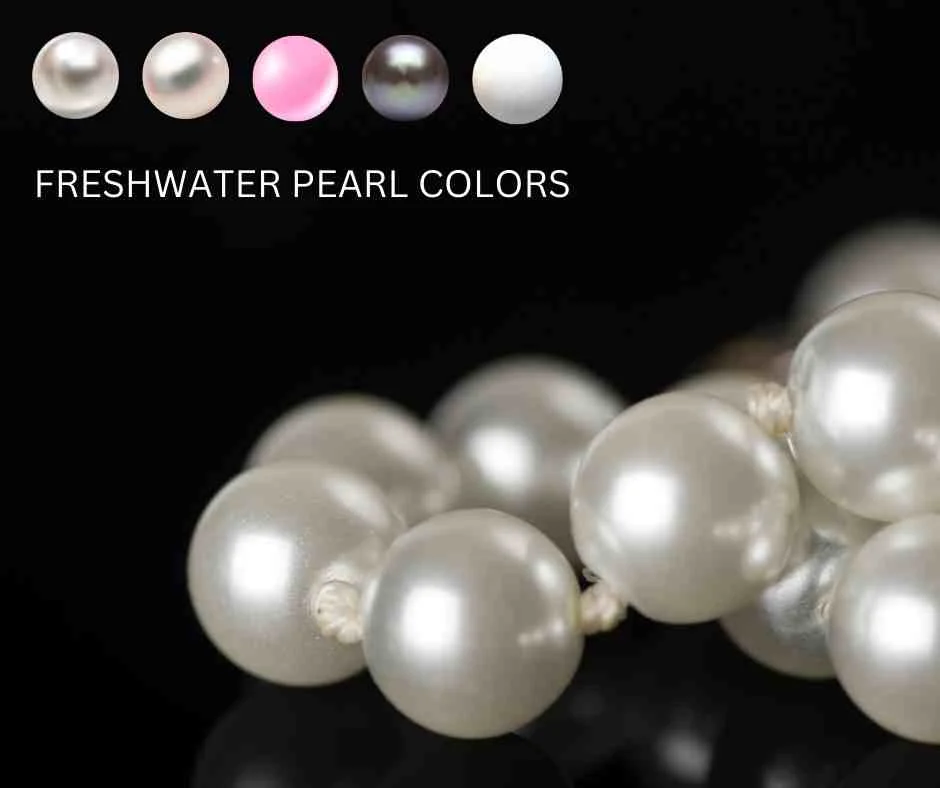
Freshwater pearls make stunning pieces of jewelry that will last for generations. They are perfect for brides looking for an exquisite piece of jewelry for their wedding day or for anyone looking to add a touch of elegance to any outfit. Plus, with their affordability, they make the perfect gift for someone special in your life.
Whether you’re looking for a classic string of pearls or something more modern and unique, freshwater pearls will give your look a timeless elegance. With proper care and storage, these gems can be passed down through generations as a precious heirloom – making them an investment that will truly stand the test of time!
Comparison of Saltwater and Freshwater pearls
| Saltwater Pearls | Freshwater Pearls | |
| Origin | Japan, China, Australia, Indonesia, Philippines (approximately 5%). | 95% of the world’s freshwater pearls are sourced from China |
| Shape | Perfectly round | Variable : Round, near round or oval |
| Pearl nucleus | Presence of a conspicuous nucleus | Do not have an apparent nucleus |
| Luster | High | Low |
| Color | White, gold, black, grey | White, orange, pink, purple (depending on the mollusk) |
| Culture cycle | Long | Short |
| Blemish | A rough texture | Relatively smooth texture compared to saltwater pearls |
| Value | Higher | Lower than saltwater |
Sea of Cortez Pearls
Sea of Cortez pearls are a rare type of pearl that are found in the Sea of Cortez, also known as the Gulf of California. These pearls form naturally inside the shells of certain oysters that can be found along the gulf’s coast. They have a unique coloration and luster compared to other types of pearls, making them highly sought after by collectors around the world.
The vast majority of sea of cortez pearls are white or gray with pink tones, although they can come in shades ranging from pale yellow to deep purple. As these natural wonders are formed only within a limited geographic area, their rarity adds to their desirability and value.
Being an organic product, each piece is truly one-of-a-kind and they make a beautiful addition to any jewelry collection. Sea of Cortez pearls have become increasingly popular in recent years, not only for their beauty but also for the story behind them. They are a reminder of nature’s ability to create something breathtakingly special that will last for generations. Therefore Sea of Cortez Pearls offer an extraordinary piece that can be treasured for many years to come.
The process of finding these treasures involves searching the deep waters off the Baja coast as well as sorting through oyster shells from local fishers and divers. This tedious task requires patience, luck, skill and knowledge about local wildlife, making it one of the most challenging activities in pearl collecting. The result is a unique and extraordinary gem that is highly valued and cherished by its owner.
Due to the rarity of sea of Cortez pearls, they usually come with a high price tag. However, many believe that these gems are worth the investment due to their exquisite beauty and long-lasting value. As the Sea of Cortez is an ever-changing landscape, its natural wonders are becoming increasingly harder to find – making them even more valuable in the future. By investing in one of these rare gems now, you can be sure to have a truly unique piece of jewelry that will be treasured for generations.
No matter what your budget is, there’s no doubt that a Sea of Cortez Pearl makes an excellent addition to any collection. Whether you’re looking for a luxurious gift or an heirloom piece to pass on in the family, these precious gems are sure to make a statement. So why not add one of nature’s finest creations to your jewelry collection today? You won’t regret it!
Be sure to shop around and find a reputable seller when purchasing Sea of Cortez Pearls. There is no substitute for quality and authenticity when it comes to this rare gem, so research your options before making a purchase. With the right guidance, you can be sure that the Sea of Cortez Pearl you choose will become an exquisite treasure that you’ll cherish forever
Simulated pearls
Simulated pearls are man-made pearls made and produced using plastics, raisins, and glass. They are very inexpensive and, of course, very readily available. They’re cheaper than natural pearls, but some people can’t tell the difference between real and simulated pearls. Simulated pearls can serve as a good entry point for people new to adorning themselves with these gems.
In my view, simulated pearls have a place for people unsure if pearls are the best ornaments for them. Furthermore, pearls are an expensive investment and may not be accessible to people in a lower socio-economic bracket.
Pearl Like Concretions
Pearl-like concretions represent natural formations in various organisms that do not contain nacre. Examples of such pearl-like concretions include Conch Pearls, Melo Melo Pearls, Crab Pearls, and Scallop Pearls, to mention a few.
Takeaway
Pearls are the most precious of all gemstones. They are beautiful and unique, with each one being a different shade of white or cream. Knowing how to care for them is important, so they stay beautiful and shiny! Good luck with your pearl collection :)
